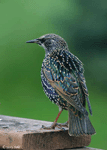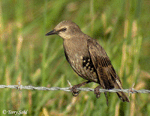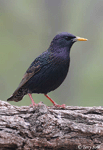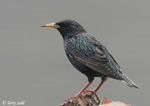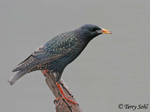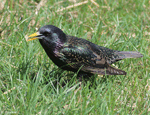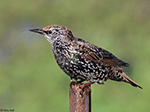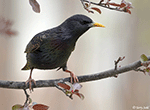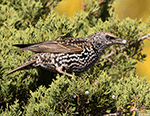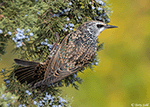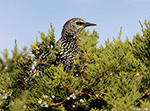European Starling
Sturnus vulgaris
| Length: 8.5 inches | Wingspan: 15 inches | Seasonality: All Seasons |
| ID Keys: Black with iridescent green and purple sheen, short tail, long straight bill | ||
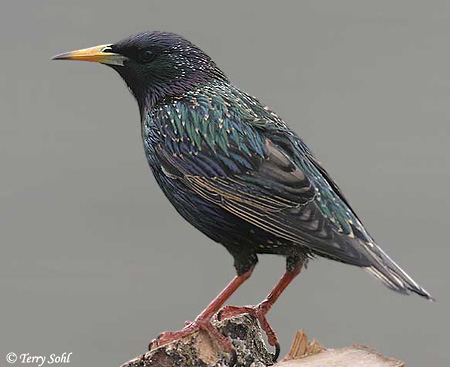 Originally
a Eurasian species introduced into New York's Central Park in 1890 by groups who
wished to populate the new world with all the bird species mentioned in
Shakespeare's works. From the original 19th century introductions, the European
Starling is now abundant throughout the United States and into Southern
Canada. Unfortunately, it competes with native species for
nesting locations, causing a population decline for species such as the Eastern
Bluebird and Red-headed Woodpecker.
European Starlings are quite gregarious, and may form very large flocks.
Originally
a Eurasian species introduced into New York's Central Park in 1890 by groups who
wished to populate the new world with all the bird species mentioned in
Shakespeare's works. From the original 19th century introductions, the European
Starling is now abundant throughout the United States and into Southern
Canada. Unfortunately, it competes with native species for
nesting locations, causing a population decline for species such as the Eastern
Bluebird and Red-headed Woodpecker.
European Starlings are quite gregarious, and may form very large flocks.
Habitat:
Urban centers, farmsteads and farm fields, or other disturbed areas. Much less common in extensive natural settings such as unbroken forest, shrub/grassland, or desert.
Diet:
Wide variety of items, including insects, earthworms, seeds, fruits, and berries. Seems to prefer insects when they are available.
Behavior:
Primarily forages on the ground, but a variety of foraging techniques are used. They will also climb through foliage for fruit, and glean insects from foliage and twigs. European Starlings also will fly-catch occasionally, observing from a perch and flying out to capture passing flying insects.
Nesting:
May through June. European Starlings are cavity nesters, although they will use a variety of suitable locations. Tree cavities were historically their preferred nesting location, but they will now readily use nest boxes or cavities and crevices in human structures. The nest is lined with a variety of material dependent upon location and what's available, but it may include feathers, grass, leaves, moss, twigs, fur, or other material. The female lays between 3 and 7 eggs, with both sexes sharing incubation duties. The eggs hatch after about 12 days, and the young will remain in the nest for another three weeks before fledging.
Song:
European Starlings are one of the most vocally talented birds in North America, with a repertoire that is virtually limitless, with their ability to even mimic some other birds. Vocalizations may include various whistles, gurgling sounds, chattering, warbling, and other vocalizations.
- Click here to hear some harsh scolding-like calls of a European Starling1
- Click here to hear various chattering and other calls of a European Starling2
- Click here to hear squeaky and whiny calls of a European Starling 3
- Click here to hear the calls of a juvenile European Starling4
Migration:
Some do move south in the fall, while others remain year-round.
Interactive eBird Map:
Click here to access an interactive eBird map of European Starling sightings
Similar Species:
Superficially similar to some blackbird species, but plumage differences, bill, and shape make it easily identifiable if seen well. The following blackbird species are those common in South Dakota and potentially confused with European Starlings (particularly since some of these species often hang out in mixed flocks with European Starlings):
- Common Grackle - Another very common species in South Dakota, Common Grackles and European Starlings are often found together in mixed flocks, particularly in the fall when massive blackbird flocks may form. Common Grackles are more uniformly colored, without the various spottings or markings European Starlings may have in their breeding or non-breeding plumage. Common Grackles have a pale eye that contrasts with the black head, while European Starlings have a dark eye.
- Brown-headed Cowbird - Another very common species in South Dakota, and another species that is sometimes found in mixed "blackbird" flocks that include European Starlings. Brown-headed Cowbird males have a very uniform black body with a brown head, while European Starlings show more markings in both breeding and non-breeding plumage. The bill of a Brown-headed Cowbird is stout and much shorter than the pointy, longer bill of a European Starling.
- Brewer's Blackbird - Brewer's Blackbirds breed in the western part of South Dakota and can be found as migrants throughout the state. They have a more uniform black plumage than a European Starling, and have a yellow eye that contrasts with the black head plumage. Their bills are also shorter than a European Starling.
- Red-winged Blackbird - One of the most common birds in the state, Red-winged Blackbirds also sometimes hang out around European Starlings. The red shoulder patch clearly differentiates them from a European Starling, as does the very uniform, black body and head.
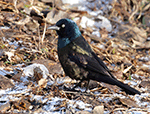 |
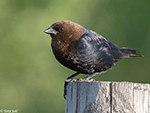 |
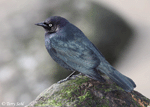 |
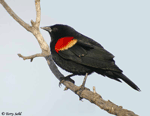 |
| Common Grackle | Brown-headed Cowbird | Brewer's Blackbird | Red-winged Blackbird |
Feeders:
European Starlings will come to feeders for a wide variety of food items, including suet, seeds, peanuts, bread, and many other items.
Birdhouses:
Much to the chagrin of those who put out nest boxes, European Starlings will use bluebird-sized or larger nest boxes. More years than not, the owl box in my yard has European Starlings using it (and to date, never an owl!).
Conservation Status:
In both the North American and European parts of their range, systematic surveys over the last few decades have shown modest declines in European Starling populations. However, they remain one of the most widely spread birds in the world, and they are common in many parts of that range. The IUCN considers the European Starling to be a species of "Least Concern".
Further Information:
Photo Information:
May 4th, 2018 - Brandon, South Dakota - Terry Sohl
Additional Photos:
Click on the image chips or text links below for additional, higher-resolution European Starling photos.
Audio File Credits:
- 1Jim Berry. Recorded in Chautauqua County, New York on May 25th, 2020. Original recording and information available on xeno-canto.
- 2Paul Marvin - Recorded in Brevard County, Florida on March 25th, 2018. Original recording and information available on xeno-canto.
- 3Thomas Magarian - Recorded in Lewis & Clark County, Montana on March 11th, 2017. Original recording and information available on xeno-canto.
- 4Ryan P. O'Donnell - Recorded in Cache County, Utah on May 24th, 2010. Original recording and information available on xeno-canto.
| Click on the map below for a higher-resolution view |
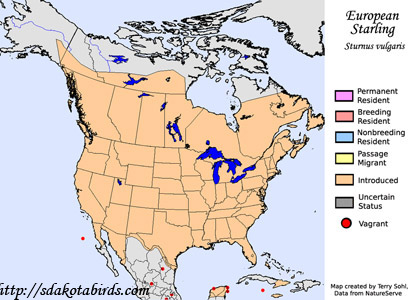 |
| South Dakota Status: Common permanent resident throughout South Dakota |
Additional European Starling Photos
Click for a higher-resolution version of these photos
